|
|
Hindustan Aeronautics Limited
Hindustan Aeronautics Limited (HAL) is an Indian state-owned aerospace and defence company headquartered in Bangalore, India. It is governed under the management of the Indian Ministry of Defence.
The corporation is primarily involved in aerospace operations and is currently involved in the design, fabrication and assembly of aircraft, jet engines, helicopters and their spare parts. It has several facilities spread across India including Nasik, Korwa, Kanpur, Koraput, Lucknow, Bangalore and Hyderabad. The HAL HF-24 Marut fighter-bomber was the first fighter aircraft made in India.
HAL was established as Hindustan Aircraft Limited in Bangalore on the 23 December 1940 by Walchand Hirachand who became Chairman of the company. After India gained independence in 1947, the management of the company was passed over to the Government of India. Hindustan Aeronautics Limited was formed on 1 October 1964 when Hindustan Aircraft Limited joined the consortium formed in June by the IAF Aircraft Manufacturing Depot, Kanpur (at the time manufacturing the HS748 under licence) and the group set-up to manufacture the MiG-21M under licence from the Sovjet Union, with its new factories planned in Koraput, Nasik and Hyderabad.
HT-2 | Pushpak |
Marut |
Kiran | Basant |
Deepak | MiG-21 |
Ajeet | Dhruv |
Sitara | Tejas
HAL HT-2
The HT-2 is a two-seat primary trainer designed and built by Hindustan Aeronautics Limited. It was the first company design to enter production in 1953 for the Indian Air Force and Navy, where it replaced the de Havilland Tiger Moth. The HT-2 is a low-wing cantilever monoplane with a fixed tailwheel landing gear. Powered by a 155 hp (116 kW) Cirrus Major III piston engine the aircraft has enclosed tandem cockpits with dual controls. Apart from military use the aircraft was also used by Indian flying schools. It was produced from 1953 until 1990.
The first prototype Hindustan HT-2 flew for the first time on 13th August 1951. This machine was registered VT-DFW and carried the prototype P. The second prototype aircraft, VT-DFY first flew on 19th February 1952 and had the shape of the fin and rudder altered considerably to increase the chord, a feature retained on production machines. The HT(Hindustan Trainer)-2 is the possessor of the Government of India's first Type Certificate, issued on 20th December 1952, and besides the prototype aircraft there were several military machines flying at that time. The first six production aircraft were delivered to the Indian Air Force towards the end of January 1953.
Salient features: The HT-2 is of stressed all-metal construction, with semi-monocoque fuselage and two-spar wing. All covering is metal. The fixed oleo-strut undercarriage is attached to the front wing spar, and features hydraulic brakes. Full equipment includes an electric starter and all controls and instruments are duplicated.
In the mid eighties, some numbers were re-engined with the Lycoming Piston engine and saw service flying with the Flying Instructor's School (FIS) in Tambaram AFS.
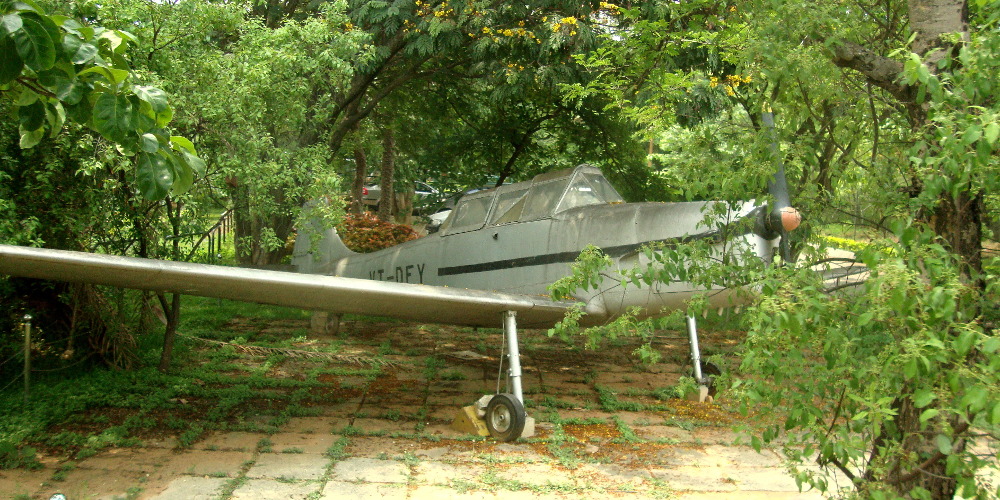
HAL HT-2, registration VT-DFY, built 1952, serial number ????
Indian Institute of Science, Bangalore, India, 14 May 2018
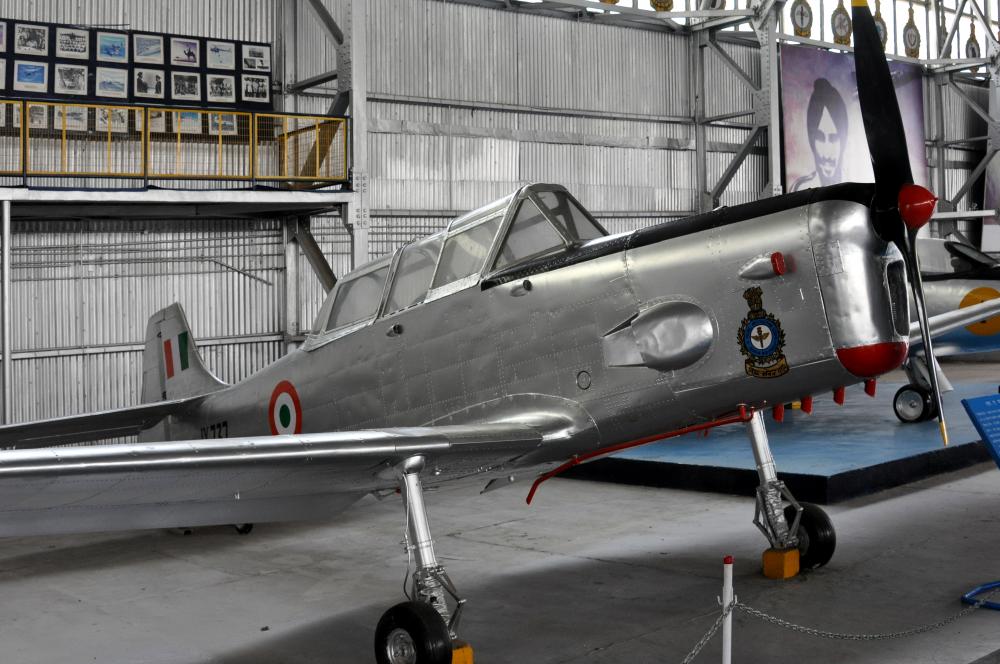
HAL HT-2, registration IX737, built ????, serial number ????
Indian Air Force Museum, Delhi, India, 28 April 2018
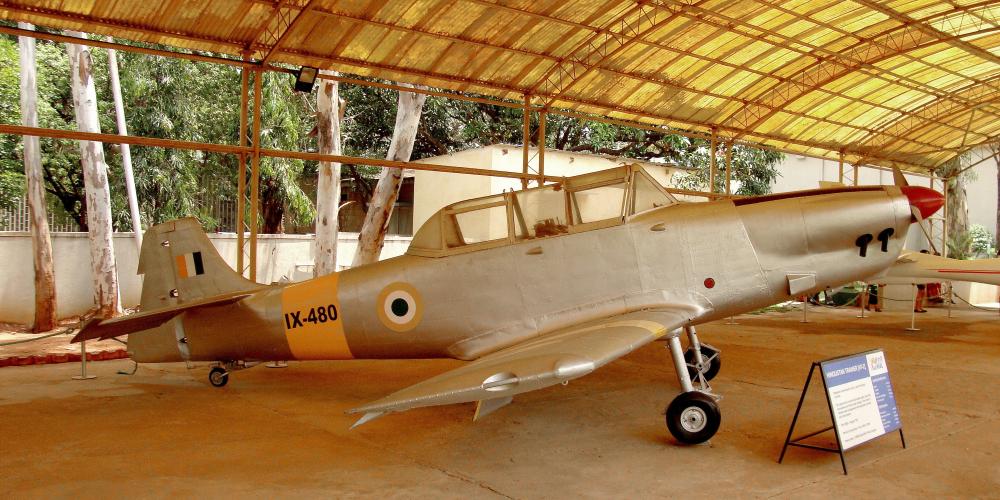
HAL HT-2 Lycoming, registration IX-480, built ????, serial number ????
HAL Aerospace Museum, Bangalore, India, 12 May 2018
HT-2 | Pushpak |
Marut |
Kiran | Basant |
Deepak | MiG-21 |
Ajeet | Dhruv |
Sitara | Tejas
HAL HUL-26 Pushpak
The Hindustan HUL-26 Pushpak was a 1950s Indian two-seat cabin monoplane designed and built by Hindustan Aeronautics Limited, based on the Aeronca Chief. It was a high-wing braced monoplane with a fixed tailwheel landing gear. The fuselage was built from metal tubing, the wing aluminum ribs on a wooden spar, all covered in fabric. The Pushpak first flew on 28 September 1958 and was powered by a 90 hp (67 kW) Continental flat-four engine.
Around 160 aircraft were produced for Indian flying clubs for use as basic trainers. Two examples were gifted to Malaysia and were later sold to private pilot owners in the United Kingdom. These examples remained in active operation in 2013.
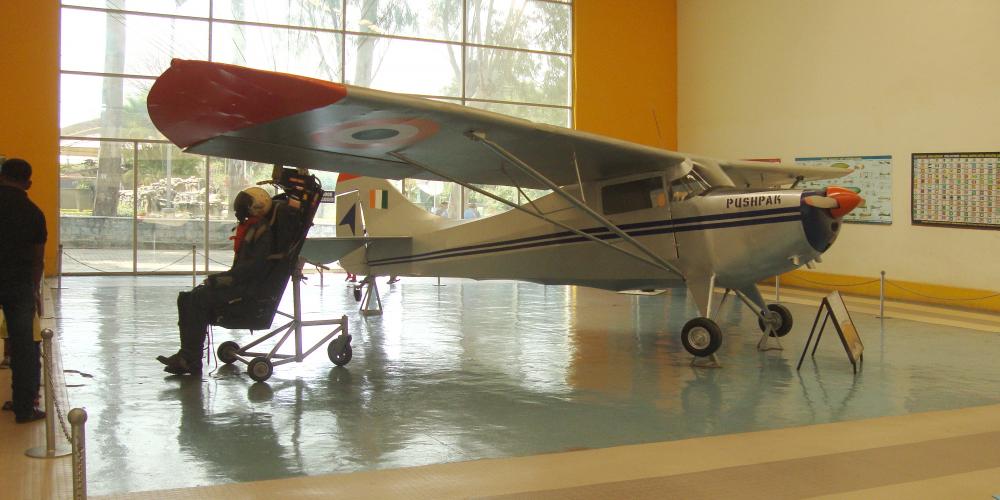
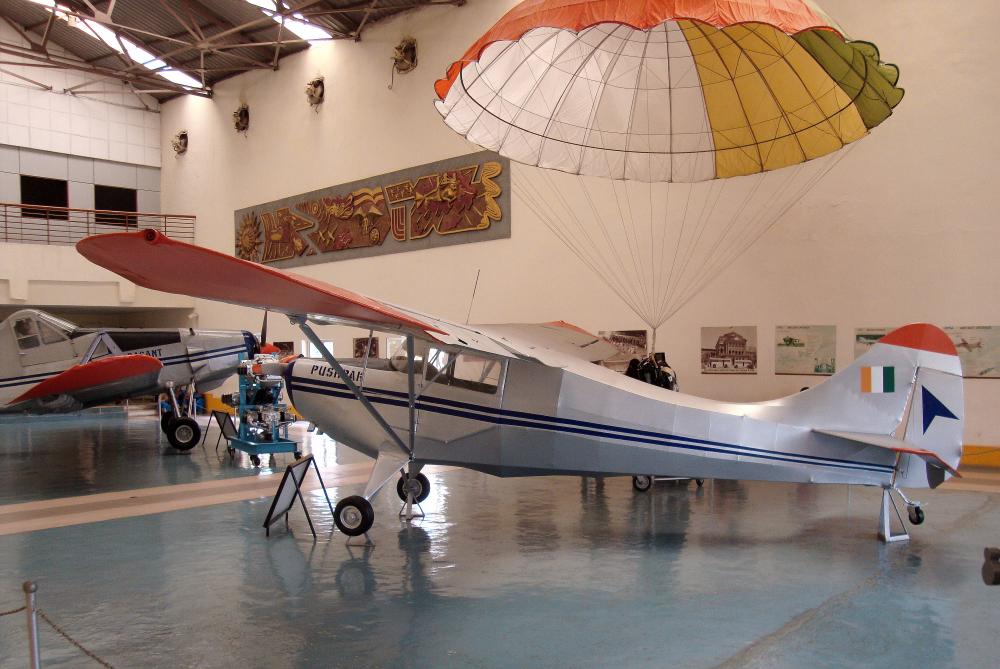
HAL HUL-26 Pushpak, registration ????, built ????, serial number ????
Indian Air Force Museum, Delhi, India, 28 April 2018
HT-2 | Pushpak |
Marut |
Kiran | Basant |
Deepak | MiG-21 |
Ajeet | Dhruv |
Sitara | Tejas
HAL HF-24 Marut
The HAL HF-24 Marut ("Spirit of the Tempest") was an Indian fighter-bomber aircraft, developed with German aircraft designer Kurt Tank as lead designer. The Marut holds the distinction of being the first Indian developed jet aircraft, and also being the first Asian jet fighter to go beyond prototype/test phase, and into successful production and active service (Russia/Soviet Union excluded). On 17 June 1961, the type conducted its maiden flight; on 1 April 1967, the first production Marut was officially delivered to the IAF. It was in IAF service From 1967-1983.
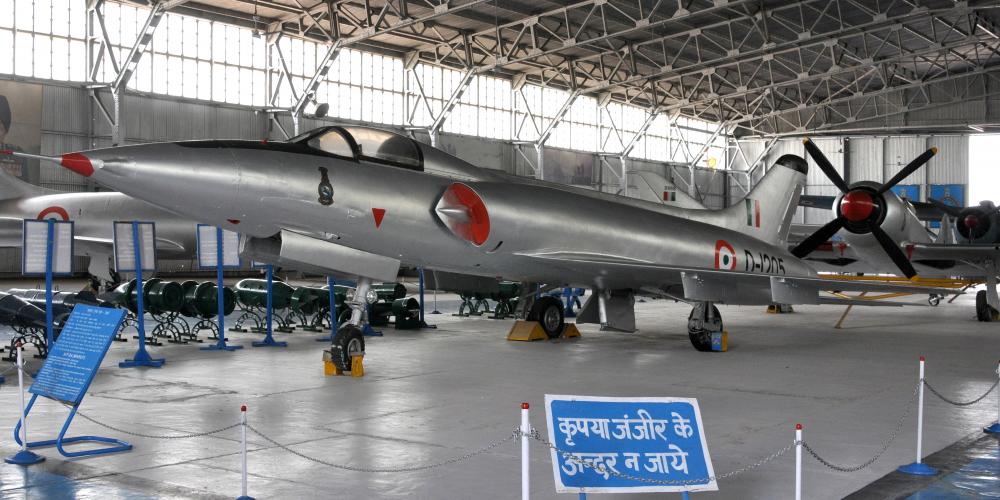
HAL HF-24 Marut, registration D-1205, built ????, serial number ????
Indian Air Force Museum, Delhi, India, 28 April 2018
HT-2 | Pushpak |
Marut |
Kiran | Basant |
Deepak | MiG-21 |
Ajeet | Dhruv |
Sitara | Tejas
HAL HJT-16 Kiran
The HAL HJT-16 Kiran ("Ray of light") is an Indian two-seat intermediate jet trainer built by Hindustan Aeronautics Limited. Used by the Indian Air Force for intermediate training for pilots trained on the HPT-32 Deepak. It is used by the Indian naval aerobatic team Sagar Pawan and was also used by the Indian Air Force aerobatic team Surya Kiran until February 2011, when the team was disbanded after its HJT-16 Mk I and Mk II aircraft were diverted to train fighter pilots.
The Kiran was designed to meet an Indian air force requirement for an intermediate jet trainer. The first aircraft powered by the Rolls Royce Viper Mk 11 was flown for the first time on 4 September 1964. The production aircraft was designated the Kiran I, and first pre-production deliveries were made to the Indian Air Force in March 1968. Later production aircraft were fitted with hardpoints under each wing for weapon training and redesignated as the Kiran IA. A total of 190 Mk I and 1A aircraft were built. An uprated version powered by a 4,200 lbf (19,000 N) thrust Bristol Siddeley Orpheus engine and enhanced weapon-carrying capability was designated the Kiran II, which first flew on 30 July 1976, and deliveries commenced in 1985 with 61 delivered by the time production ended in 1989.
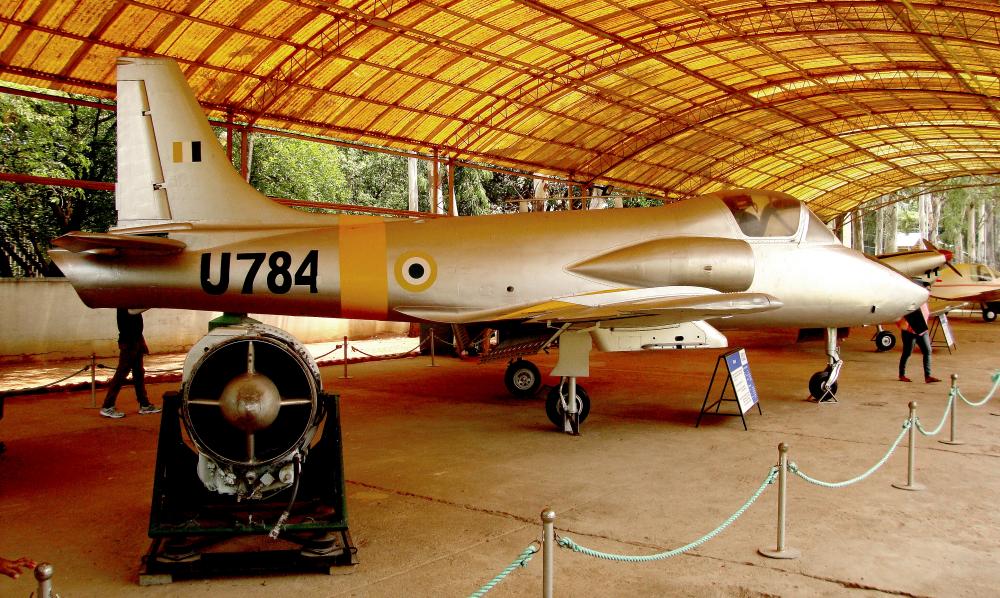
HAL HJT-16 Kiran Mk II, registration U784, built ????, serial number HAL/JT/WC/111
HAL Aerospace Museum, Bangalore, India, 12 May 2018
HT-2 | Pushpak |
Marut |
Kiran | Basant |
Deepak | MiG-21 |
Ajeet | Dhruv |
Sitara | Tejas
HAL HA-31 Basant
The Hindustan Aeronautics HA-31 Basant ("Spring") is an agricultural monoplane. Design of the aircraft started in 1968 with a cockpit directly over the wing leading edge, designated the HA-31 Mk 1. It was re-designed as the HA-31 Mk II Basant and first flew on the 30 March 1972. The Basant is a conventional braced low-wing monoplane with a fixed tailwheel landing gear and powered by a 400 hp (298 kW) Avco Lycoming IO-720 piston engine. It had a raised cockpit to give the pilot a good all-round view during spraying operations. Production ended in 1980 after 39 aircraft had been built.
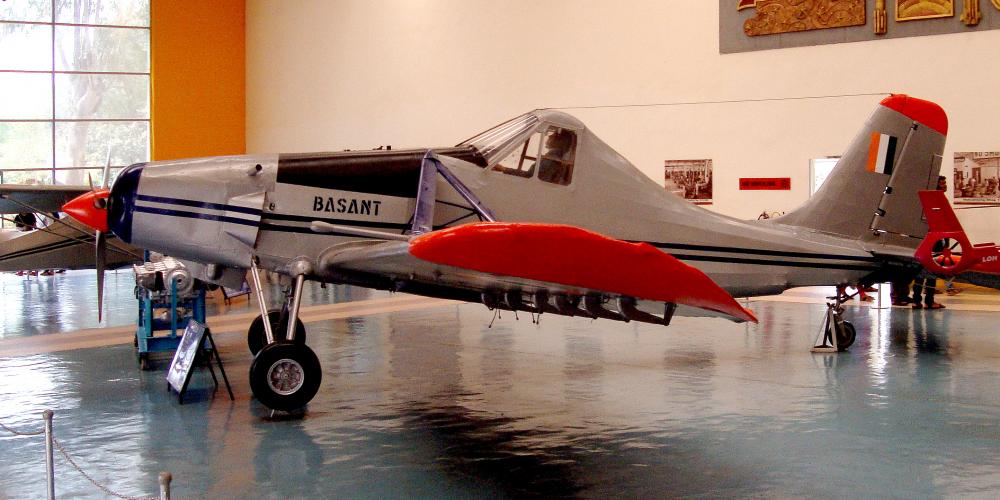
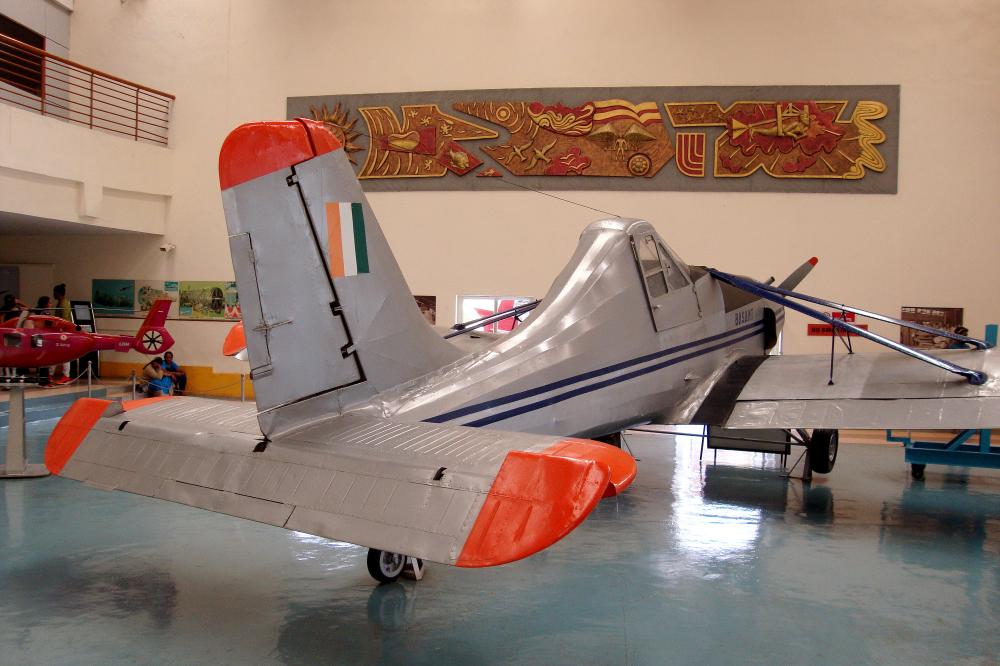
HAL HA-31 Basant, registration ????, built ????, serial number ????
HAL Aerospace Museum, Bangalore, India, 12 May 2018
HT-2 | Pushpak |
Marut |
Kiran | Basant |
Deepak | MiG-21 |
Ajeet | Dhruv |
Sitara | Tejas
HAL MiG-21
The Mikoyan-Gurevich MiG-21 is a supersonic jet fighter and interceptor aircraft, designed by the Mikoyan-Gurevich Design Bureau in the Soviet Union.
HAL manufactured a total of 150 MiG-21Ms under licence from the Soviet Union between 1973 and 1981, starting with serial number C-1474 till C-1691, which was retired by 2017 from the Indian Air Force.
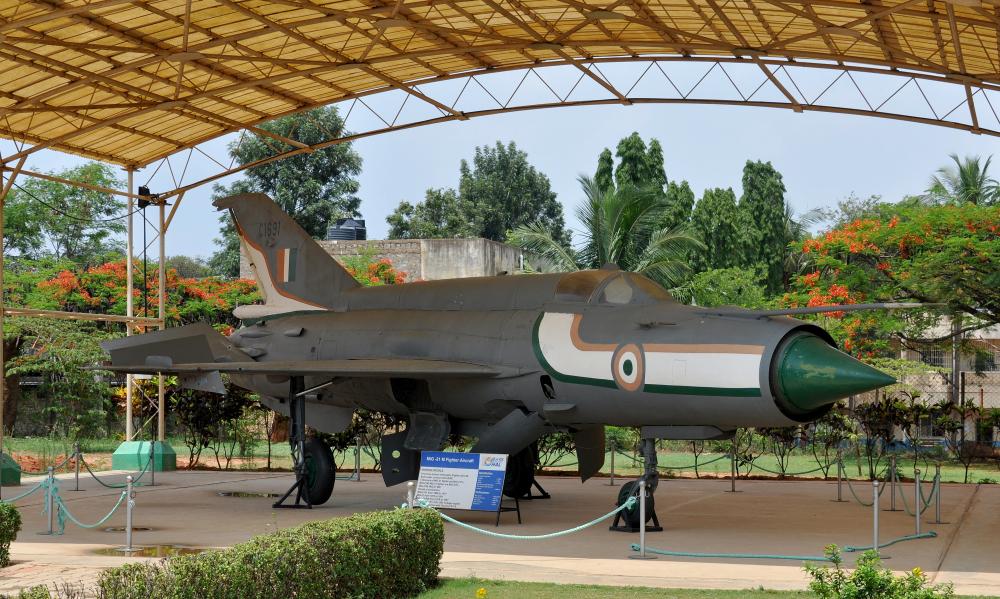
Mikoyan-Gurevich MiG-21M, registration C1691, built ~1980, serial number C-1691
HAL Aerospace Museum, Bangalore, India, 12 May 2018
HT-2 | Pushpak |
Marut |
Kiran | Basant |
Deepak | MiG-21 |
Ajeet | Dhruv |
Sitara | Tejas
HAL Ajeet
The HAL Ajeet ("Invincible" or "Unconquerable") was a jet-powered fighter aircraft developed and manufactured by Hindustan Aeronautics Limited (HAL). It was operated by the Indian Air Force (IAF) between 1977 and 1991.
The Ajeet is a derivative of the British Folland Gnat light fighter aircraft. The Gnat, which had been procured in large numbers for the IAF and produced under license by HAL, had acquitted itself favourably during its Indian service, including in active combat roles during multiple conflicts with the neighbouring nation of Pakistan, including the Indo-Pakistani Wars of 1965 and 1971. As such, the IAF had a positive attitude towards the type, despite observing shortcomings in maintainability and some subsystems. Thus, during 1972, the service issued a requirement calling for the development of an upgraded and more capable variant of the Gnat, leading to the development of the Ajeet by HAL.
In the design phase of the Ajeet, HAL redesigned several aspects of the aircraft while seeking to improve both the reliability and effectiveness of several subsystems, such as the avionics and hydraulic systems. The adoption of a wet wing expanded the fighter's internal fuel capacity and freed-up several underwing hardpoints for other purposes, effectively increasing both the range and payload capability of the aircraft. On 6 March 1975, the first of two Ajeet prototypes, produced via the conversion of the final two licence-produced Gnat fighters, conducted its maiden flight. The satisfactory performance of these prototypes contributed to the issuing of a production order for the Ajeet. On 30 September 1976, the first production aircraft performed its maiden flight. Introduced to service during the following year, the Ajeet had a relatively brief and unremarkable service life, equipping only a single IAF squadron and being withdrawn from service in 1991.
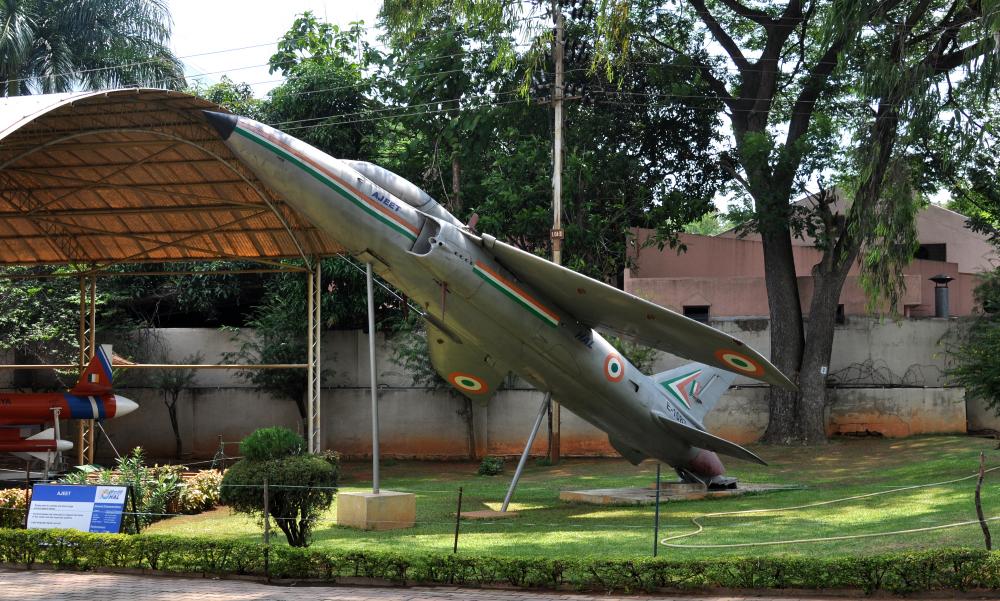
HAL Ajeet Mk.1, registration D-1205, built 1976, serial number 1
HAL Aerospace Museum, Bangalore, India, 12 May 2018
HT-2 | Pushpak |
Marut |
Kiran | Basant |
Deepak | MiG-21 |
Ajeet | Dhruv |
Sitara | Tejas
HAL HPT-32 Deepak
The HAL HPT-32 Deepak ("Lamp") is an Indian prop-driven primary trainer manufactured by Hindustan Aeronautics Limited. The student and the instructor sit side-by-side. The aircraft can accommodate one passenger.
The prototype first flew on 6 January 1977, followed by a second on March 1979. However the early prototypes failed to meet the specific requirements of the IAF and thus the aircraft was re-designed with various aerodynamic changes and underwent a weight reduction program. The third prototype flew in July 1981. However production deliveries did not start till 1984, with 12 aircraft handed over to IAF, which were based at the IAF's Elementary School at Bidar.
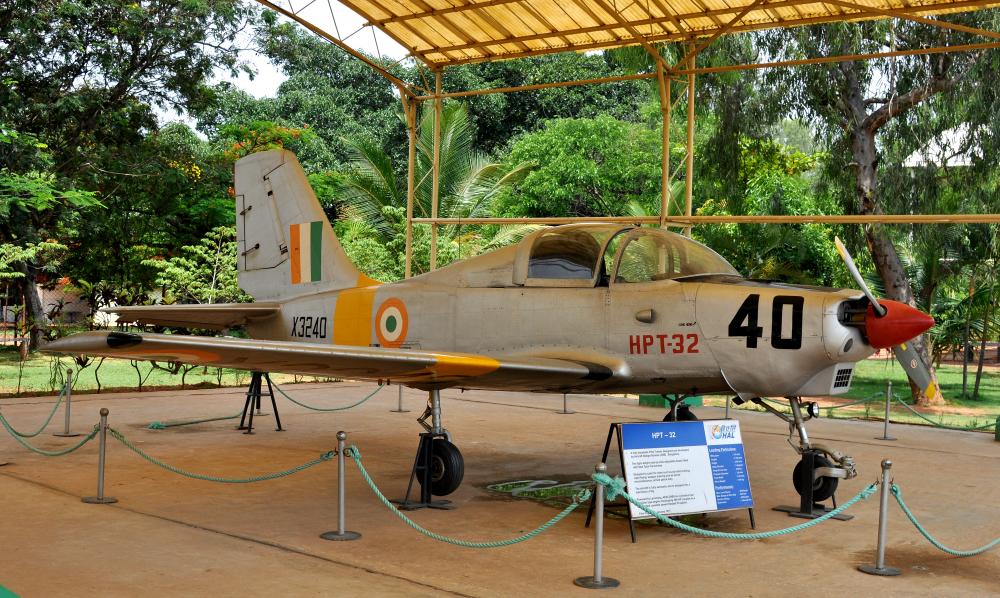
HAL HPT-32 Deepak, registration X3240, built ????, serial number ????
HAL Aerospace Museum, Bangalore, India, 12 May 2018
HT-2 | Pushpak |
Marut |
Kiran | Basant |
Deepak | MiG-21 |
Ajeet | Dhruv |
Sitara | Tejas
HAL Dhruv
The Dhruv ("Polar Star") is a utility helicopter developed and manufactured by HAL. The development was first announced in November 1984, and it was subsequently designed with assistance from MBB in Germany. The helicopter first flew in 1992; however, its development was prolonged due to multiple factors including the Indian Army's requirement for design changes, budget restrictions, and sanctions placed on India following the 1998 Pokhran-II nuclear tests.
The Dhruv entered service in 2002. It is designed to meet the requirement of both military and civil operators, with military variants of the helicopter being developed for the Indian Armed Forces, while a variant for civilian/commercial use has also been developed. The helicopter was first exported to Nepal and Israel.
Military versions in production include transport, utility, reconnaissance and medical evacuation variants. Based on the Dhruv platform, the HAL Light Combat Helicopter (LCH) a dedicated attack helicopter and HAL Light Utility Helicopter (LUH), a utility and observation helicopter, are currently being developed. As of August 2013, more than 200 HAL Dhruv have been produced for different customers.
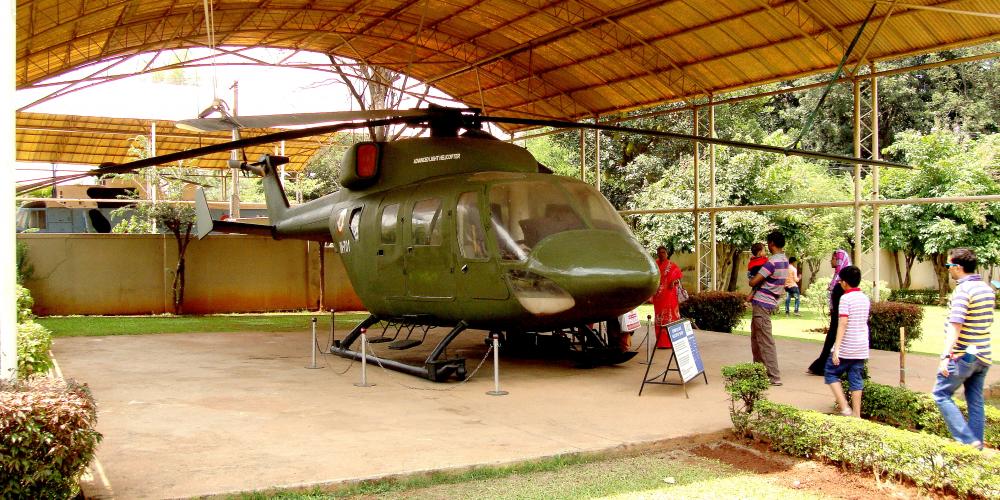
HAL Dhruv, registration IN-701, built ????, serial number ????
HAL Aerospace Museum, Bangalore, India, 12 May 2018
HT-2 | Pushpak |
Marut |
Kiran | Basant |
Deepak | MiG-21 |
Ajeet | Dhruv |
Sitara | Tejas
HAL HJT-36 Sitara
The HAL HJT-36 Sitara ("Star") is a subsonic intermediate jet trainer aircraft developed by HAL for the Indian Air Force and the Indian Navy. The HJT-36 will replace the HAL HJT-16 Kiran as the Stage-2 trainer for the two forces.
The Sitara is a conventional jet trainer with low swept wings, tandem cockpit and small air intakes for the engine on either side of its fuselage. It entered limited series production by 2010 but according to the Indian Air Force officials it remains "unfit" for service due to technological issues (as of March 2017).
HAL started design work on an intermediate jet trainer (IJT) in 1997. The concept was developed as a successor to HAL's earlier trainer, the HJT-16 Kiran, introduced in 1968. In 1999, following reviews by the Indian Air Force, the Government of India awarded HAL a contract for development, testing and certification of two prototype IJT aircraft.
The first and second prototypes of the HJT-36, labelled PT-1 and PT-2, flew on 7 March 2003 and in March 2004, respectively. The program was then delayed with the Air Force assessing the SNECMA Turbomeca Larzac engine, with 14.1 kN of thrust, as under-powered. In response, in August 2005, HAL reached a deal to replace the SNECMA engine with the NPO Saturn AL-55I with 16.9 kN of thrust. The deal also provided for license-production of the engine in India by HAL. Further delays were caused by delays in delivery of the NPO Saturn engine by 2 years, as well as due to two accidents in February 2007 and in February 2009 involving each of the prototypes, which grounded the aircraft for repairs and investigations. The first AL-55I engine was received from Russia on 28 December 2008, 2 years later than committed, and was installed on PT-1. Following ground taxiing trials, flight tests with the new engine started on 9 May 2009.
After further development and extensive testing, the Indian Air Force placed an order for 73 aircraft. After over 280 test flights, the aircraft entered limited series production in 2009 for the first 12 aircraft to be delivered to the Air Force. The first flight test for the limited series aircraft occurred in January 2010, and initial operational capability was expected by July 2011. The Air Force order was expected to grow to over 200 aircraft. The third Prototype in development phase performed the first Engine Ground Run on 27 July 2012. In December 2013, HAL declared that Sitara was 'weeks' from certification. On 19 February 2014 the Indian MOD submitted a statement that the development of IJT was in the advanced stages of certification, with more than 800 test flights completed so far. The activities were progressing well with completion of sea level trials, night flying trials, high altitude trials as well as weapon and drop tank trials. The activities left for obtaining Final Operational Clearance (FOC) are the refinement of stall characteristics, and spin testing which will be commenced as soon as stall characteristics were refined. All efforts were being made to achieve FOC by December 2014. Production of aircraft was to commence immediately thereafter. However, the stall cannot be tested until HAL redesigns the entire aircraft to correct its "inherent asymmetry". BAE was consulted on certain design changes, specifically the tail. Afterwards the design was put to mathematical and wind tunnel tests. The modified aircraft was expected to complete the spin tests by September 2015, and the production of 85 aircraft for the Indian Air Force to begin.
In March 2017 Jane's reported that due to the HJT-36's "unresolvable" issues associated with critical stall and spin characteristics the aircraft is not ready to serve as an intermediate jet trainer for Indian Air Force pilots.
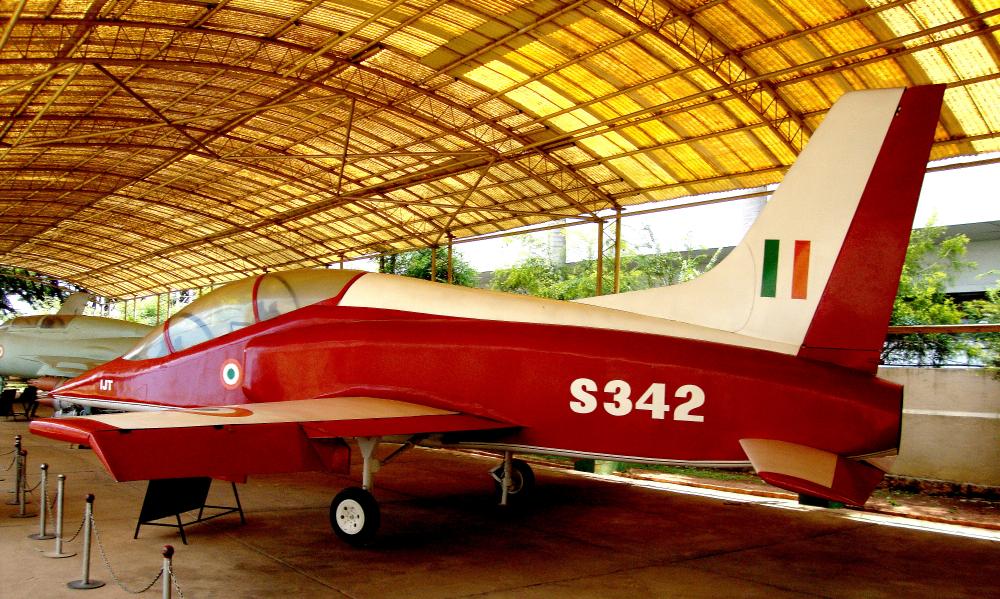
HAL HJT-36 Sitara, registration S342, built ????, serial number ????
HAL Aerospace Museum, Bangalore, India, 12 May 2018
HT-2 | Pushpak |
Marut |
Kiran | Basant |
Deepak | MiG-21 |
Ajeet | Dhruv |
Sitara | Tejas
HAL Tejas
The HAL Tejas (Sanskrit: "Fire" or "Illumination") is a single-seat, single-jet engine, multirole light fighter designed by the Aeronautical Development Agency (ADA) and Hindustan Aeronautics Limited (HAL) for the Indian Air Force and Navy. It came from the Light Combat Aircraft (LCA) programme, which began in the 1980s to replace India's ageing MiG-21 fighters. In 2003, the LCA was officially named "Tejas".
Tejas has a tail-less compound delta-wing configuration with a single dorsal fin. This provides for high maneuverability. Its wing root leading edge has a sweep of 50°, the outer wing leading edge has a sweep of 62.5°, and trailing edge forward has a sweep of 4°. It integrates technologies such as relaxed static stability, fly-by-wire flight control system, multi-mode radar, integrated digital avionics system, composite material structures, and a flat rated engine. It is the smallest and lightest in its class of contemporary supersonic combat aircraft.
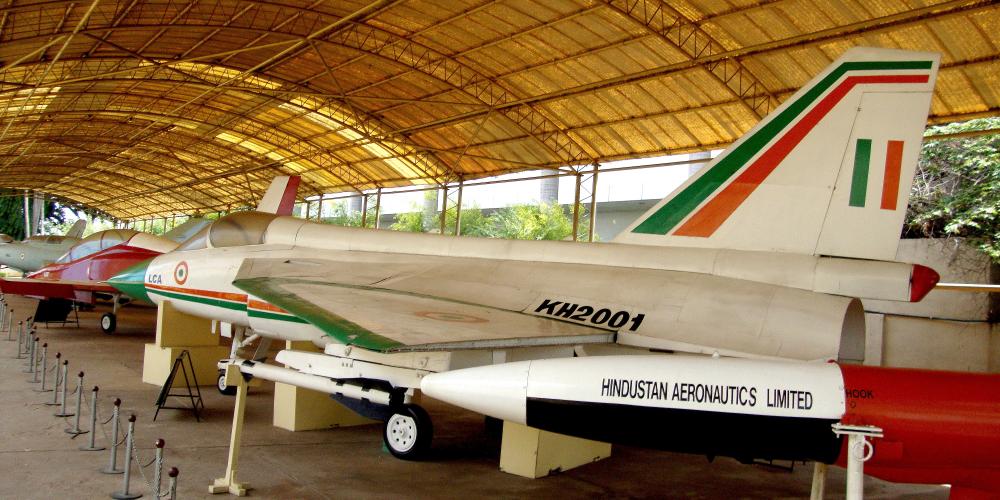
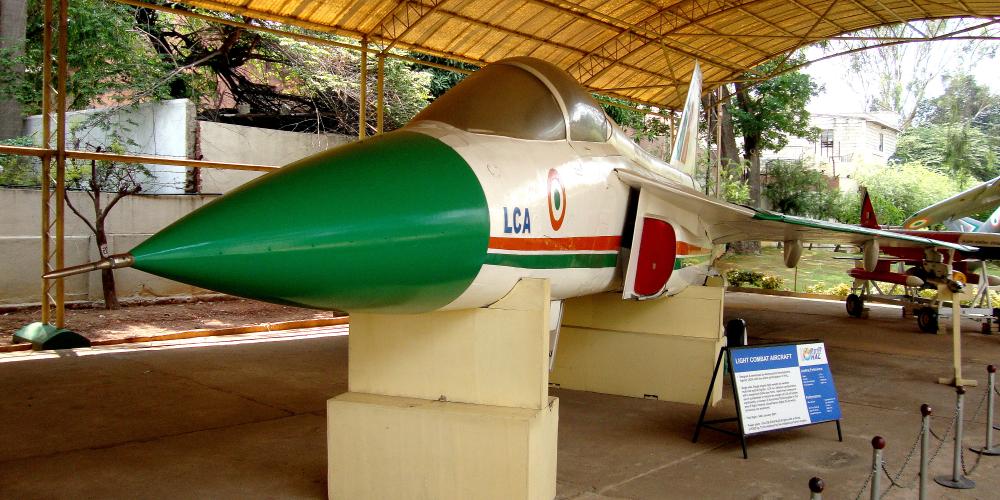
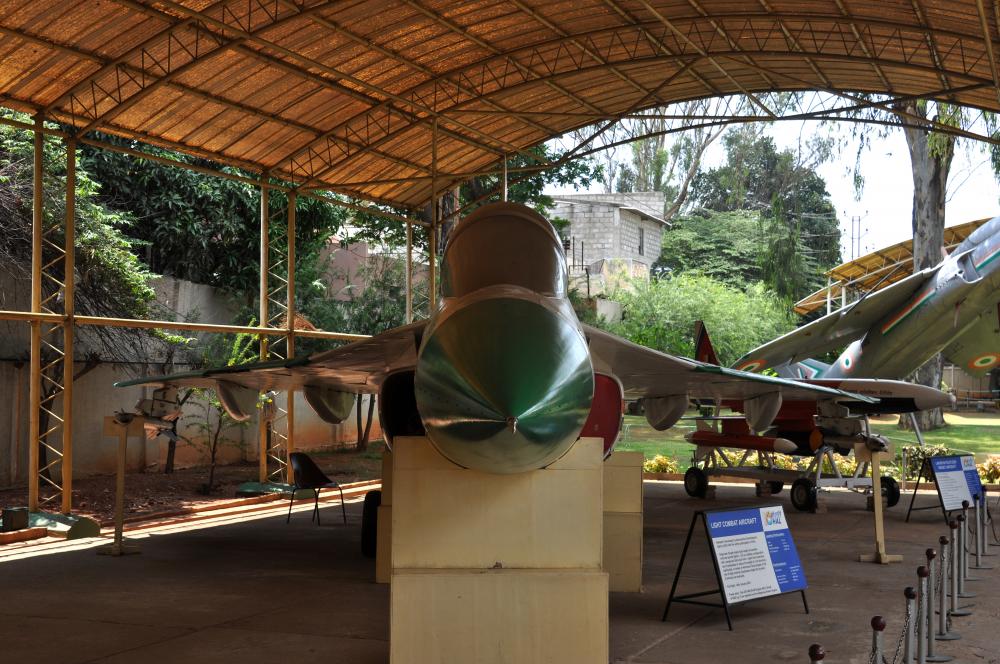
HAL Tejas LCA, registration KN2001, built 2001, serial number TD-1
HAL Aerospace Museum, Bangalore, India, 12 May 2018


HAL Tejas LCA, full-scale model
Minsk Square, Cubbon Park, Bangalore, India, 14 May 2018
HT-2 | Pushpak |
Marut |
Kiran | Basant |
Deepak | MiG-21 |
Ajeet | Dhruv |
Sitara | Tejas
|


















